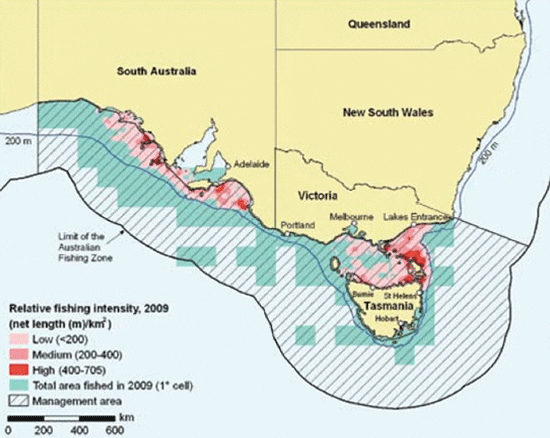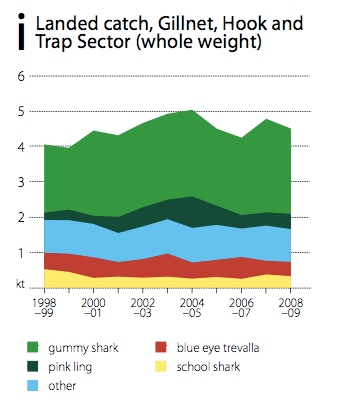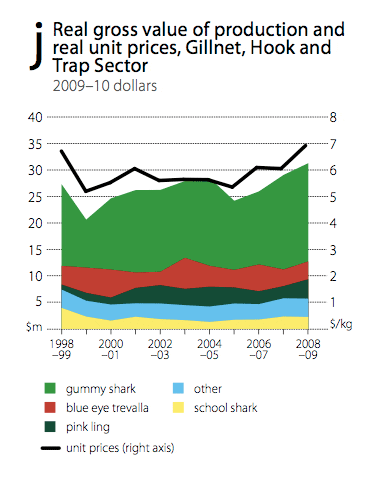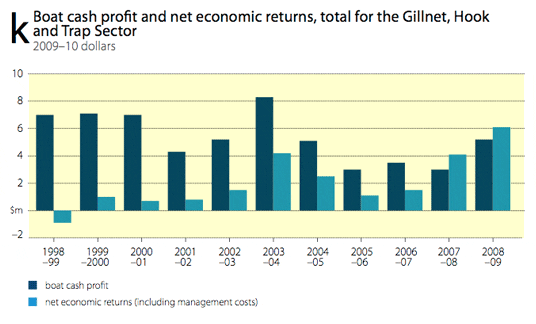The sector
The Gillnet, Hook and Trap Sector (GHTS) comprises what were previously the South East Non-Trawl Fishery and the Southern Shark Fishery. Both fisheries were in operation for a long time before being merged into the GHTS—the South East Non-Trawl Fishery since the early 1900s and the Southern Shark Fishery since 1927 (AFMA 2004). The sector extends south from southern Queensland to the western border of South Australia and includes waters to the south of Tasmania (map 3). Gear types that can be used in the sector include gillnets, droplines, demersal longlines, automatic longlines and, to a lesser extent, traps. Gillnets are used to target shark species (mainly gummy shark), while all other methods are used primarily to target finfish species, with some targeting of shark species using line methods. Operators are only permitted to use the gear types specified on their boat statutory fishing right or fishing permit (AFMA 2004).
Like the Commonwealth Trawl Sector, the GHTS is a sector of the Southern and Eastern Scalefish and Shark Fishery (SESSF). Accordingly, the management of the sector is also based on output controls—species-based total allowable catches (TACs) and individual transferable quotas(ITQs). ITQ management was not implemented in the sector until 1998 when it was expanded to cover catches of blue eye trevalla, blue warehou and pink ling, given increasing catches of these species in that sector. ITQ management of all quota-managed species in the South East Trawl Fishery was then expanded to the non-trawl sector in 2001, when global TACs were set across both sectors (Wilson et al. 2010). The harvest strategy framework adopted for the SESSF in 2005 also applies to the GHTS and provides a more strategic approach for determining TACs.
The framework identifies TAC setting rules for different species based on whether a stock (or an indicator of stock) declines or rises above or below predetermined levels (Larcombe and McLoughlin 2007). As in the CTS, a range of input controls are also used to manage the fishery, including area and seasonal closures, limited entry, catch size restrictions and a variety of gear restrictions. Automatic longlining is a relatively new fishing method used in the GHTS. It is a form of demersal longlining in which some of the functions are automated, allowing operators to set and haul more hooks (AFMA 2005). Operators using this method of fishing are subject to specific rules regulating where and when they may use this method. Furthermore, all operations using this method are required to comply with additional restrictions, including an upper hook limit of 15,000 hooks, mandatory use of bird scaring (tori) lines, observer coverage and integrated computer vessel monitoring system requirements (AFMA 2005).


In November 2005, the Australian Government announced the $220 million Securing Our Fishing Future initiative. The initiative aimed to reduce excess effort in fisheries subject to overfishing or at significant risk of overfishing. As part of the initiative, $149 million was set aside for a voluntary tender process for fishing businesses to exit the industry.
A total of 114 statutory fishing rights/permits were purchased from the GHTS by the conclusion of the tender process in November 2006 (Vieira et al. 2010).
The total landed catch for the GHTS in 2008–09 was 4509 tonnes (whole weight equivalent) (figure i). This is 11 per cent below the peak catch of 5040 tonnes recorded in 2004–05. Gummy shark catch typically accounts for around 50 per cent of the sector’s total catch and made up 54 per cent in 2008–09. Other key species include pink ling (which accounted for 10 per cent of catch in 2008–09), blue eye trevalla (9 per cent) and school shark (7 per cent).
As gummy shark catches were relatively stable over the period 1998–99 to 2008–09, the sector’s total catch has also been stable. Relatively strong prices in 2008–09 contributed to an increasing trend in the real gross value of production (GVP) in the sector, with GVP peaking in 2008–09 at $31.3 million (figure j). This represents an 8 per cent increase relative to 2007–08 and is 52 per cent higher than the lowest value recorded in 1999–2000. Driving the increase in 2008–09 was a 60 per cent ($1.4 million) increase in the value of pink ling landings and a 4 per cent ($0.7 million) increase in gummy shark value. These latter increases reflect a 39 per cent increase in the real price for pink ling and a 14 per cent increase for gummy shark.


The 2010 survey collected data for the 2007–08 and 2008–09 financial years. The survey method used by ABARES is described in appendix B. The target population for the GHTS survey was defined as any boat that recorded catch of more than 1750 kilograms in either of these two financial years. This limited the population to 67 boats in 2007–08 and 68 in 2008–09. The survey population can be divided into subgroups based on method.
In 2007–08, the population included 44 gillnet boats, 6 autolongliners and 17 boats that employed other line methods (demersal longline or dropline). In 2008–09, the population included 46 gillnet boats, 6 autolongliners and 16 boats that employed other line methods. Out of this survey population, 16 boats were sampled in each year, which was a sample size approximately equivalent to 24 per cent in both 2007–08 and 2008–09. This sample included 9 gillnet boats, 3 autolongline boats and 4 boats using other line methods in both years.
Survey-based estimates of average boat-level financial performance are presented in nominal terms in table 9. Definitions of items included in table 9 are provided in appendix A. Financial performance estimates include the receipts and costs earned and incurred by boats in both the fishery being surveyed and any other fisheries that sampled boats may have operated in during the survey years. Other fisheries operated in by sampled GHTS boats included the South Australian Rock Lobster Fishery and offshore high sea fisheries. Consequently, the receipts and costs displayed in table 9 relate to fishing activities in both the GHTS and these other fisheries.
The results reported in table 9 are divided into ‘gillnet boats’ and ‘all boats’. Gillnet fishing differs considerably from other methods such as auto-longlining and demersal longlining, particularly in regard to cost structures and species targeted. As a result, it is necessary to stratify the survey population by method to ensure sampled gillnet boats can only represent other gillnet boats in the population and, similarly, sampled autolongline boats can only represent other autolongline boats in the population. As a result, sampled boats are restricted to representing non-sampled boats that were likely to have a similar cost and revenue structure
In nominal terms, average seafood receipts per boat for all boats in the GHTS increased between 2007–08 and 2008–09 from $527 000 to $587 000. This represents an increase of 11 per cent. For gillnet boats, average seafood receipts increased by 1 per cent over the survey period. Average seafood receipts per gillnet boat were $545 000 in 2007–08 and $551 000 in 2008–09. Previous survey results for 2006–07 (Vieira et al. 2008) reveal that average seafood receipts in the GHTS increased by 39 per cent between 2006–07 and 2007–08 (nominal terms). This increase is consistent with the combination of a 15 per cent decrease in boat numbers and 16 per cent increase in nominal GVP.
CostsAverage total cash costs per boat for all boats in the GHTS increased in 2008–09. Nominal total cash costs were $489 000 a boat in 2007–08 and increased by 3 per cent to $504 000 a boat in 2008–09. The key cost items in both years were crew (accounting for 40 per cent of total cash costs in 2008–09), fuel (9 per cent), leasing (13 per cent), and repairs and maintenance (9 per cent). Together, these cost items accounted for 72 per cent of total cash costs for the average GHTS boat. One of the key changes in the GHTS was the 17 per cent decline in average fuel cost per boat between 2007–08 and 2008–09, largely reflecting the fall in average fuel prices between the two years. I
n 2008–09, cash costs for the average gillnet boat fell below those for the average GHTS boat. Total cash costs were $510 000 a boat in 2007–08 and decreased by 4 per cent to $491 000 a boat in 2008–09. Once again, crew, fuel, leasing, and repairs and maintenance accounted for the major share of total cash costs per boat—75 per cent in 2008–09. Crew costs for gillnet boats decreased by 7 per cent, despite increases of 5 per cent for all boats in the GHTS. At the same time, fuel costs fell by 7 per cent, slightly less than the decrease of 17 per cent in the fuel costs for all GHTS boats.
Boat cash income reflects the difference between total cash receipts and total cash costs per boat. For the average GHTS boat, boat cash income increased in nominal terms from $46 000 a boat to $107 000 a boat between 2007–08 and 2008–09, which was an increase of 131 per cent. This compares with a 91 per cent increase for the average gillnet boat from $40 000 a boat to $77 000 a boat over the same period. Boat business profit, which is boat cash income less depreciation, for the average boat in the GHTS increased from $18 000 a boat in 2007–08 to $80 000 a boat in 2008–09. Boat business profit for gillnet boats improved by 182 per cent in 2008–09 to $58 000 a boat. Profit at full equity, which is boat business profit plus interest, leasing and rent, increased from $127 000 a boat in 2007–08 to $181 000 a boat in 2008–09 for the average GHTS boat. This profit measure is calculated by removing all costs associated with interest, leasing and rent to treat these items as transfers to other entities rather than costs. While these items impose a cost on the operator, they represent profits that have been redistributed to other investors in the fishery. As such, profit at full equity represents the average return to the business unit had the boat and capital (including quota and licences) been fully owned by the operator. Profit at full equity for gillnet boats improved from $134 000 a boat in 2007–08 to $169 000 a boat in 2008–09.
Rates of returnThe rate of return to boat capital, excluding the value of quota and licences, for the average GHTS boat improved substantially between survey years, from 32 per cent a boat in 2007–08 to 41 per cent a boat in 2008–09. This compares with a 44 per cent return to boat capital for the average gillnet boat. To allow the financial performance of all boats to be compared irrespective of the operators’ equity in the business unit, rates of return are calculated assuming all capital assets are owned by the operator. The rate of return to full equity includes the value of quota and licences in addition to other capital, and therefore provides an indication of the return to total capital invested in the business unit. It reflects changes in the value of capital, quota and licences, as well as changes in boat-level profitability. The rate of return to full equity for the average boat in the GHTS increased from 8 per cent a boat in 2007–08 to 11 per cent in 2008–09. For the average gillnet boat, a similar improvement occurred from 8 per cent a boat in 2007–08 to 11 per cent in 2008–09.
Sector-level economic performanceThe boat-level estimates displayed in table 9 indicate the financial performance of the average boat in the GHTS in 2007–08 and 2008–09.
However, the measure presented is generally not an accurate indicator of sector level economic performance as it includes revenues and costs associated with operations in other fisheries and excludes some key economic costs. Table 10 presents historical receipts, costs and key measures of sector level profitability; namely, boat cash profit and net economic return, in real terms. Boat cash profit measures the difference between cash receipts and cash costs in a sector. As such, it reveals the cash position of the sector. Net economic return, in comparison, reveals economic profitability, as it incorporates depreciation costs and the opportunity cost of capital and labour and treats all interest and leasing expenditure as an economic return to external investors in the sector. Furthermore, it includes the total amount spent on managing the sector, rather than just the management fees recovered from operators. A more detailed explanation of net economic return is included in appendix A.
In real terms, fishing income peaked in 2003–04 at $31.2 million (2009–10 dollars). After consecutive falls in the two years that followed, fishing income has remained relatively constant at around $25 million since 2006–07. This is in large part because the sector is controlled with TACs, the level of which has remained relatively constant for key species. Without changes in fish prices and TACs, fishing income will remain relatively constant, irrespective of changes in the fleet structure.
Operating costs peaked in 2004–05 (the year after income peaked) in real terms at $24.6 million. In the year that followed, costs fell sharply to slightly more than $20 million and have remained at that level since. As income and costs stabilised, movements in boat cash profit also became relatively stable between 2005–06 and 2007–08. However, in 2008–09 boat cash profit increased by $2.2 million from $3 million in 2007–08 to $5.2 million in 2008–09.
While boat cash profit indicates a sector’s cash position, net economic return is a more relevant measure of economic performance. It incorporates depreciation expenses, the opportunity costs of owner and family labour and the opportunity cost of capital—costs not accounted for in boat cash profit. Net economic returns also include a deduction of fishery management costs. These management costs include both management fees paid for by fishery operators (accounted for under ‘licence fees and levies’ in table 9) and non-recovered management costs paid for by government (not accounted for in table 9). An explanation of the calculation of net economic returns is included in appendix A.
With the inclusion of economic costs and the removal of interest, leasing and management fees (see appendix A for explanation), net economic returns (excluding management costs) have also recovered strongly since 2005–06. The increase in net economic returns has been greater than the increase in boat cash profit, in part because of reductions in the opportunity costs of capital and depreciation, arising from the smaller fleet size of the sector. From 2005–06 to 2008–09, while real boat cash profit increased by 75 per cent, real net economic returns (excluding management costs) increased by 146 per cent, from $3.2 million in 2005–06 to $7.9 million in 2008–09. Once management costs are included, net economic returns have increased almost fivefold—from $1.1 million in 2005–06 to $6.1 million in 2008–09 (figure k).
Factors outside the control of fishery management affect both net economic returns and other measures of financial performance in the sector. For example, movements of the Australian dollar affect the prices received by fishers as well as the prices of some fishery inputs, such as fuel. More generally, the price of inputs such as fuel and gear are not controlled by fishery managers. However, the fishery manager can alter management settings to ensure net economic returns can be maximised given prevailing input and output prices. This may require periodic review of the optimal level of catch and effort in the fishery to ensure stocks are maintained at profitable levels.

Non-survey–based estimates of real net economic returns for 2009–10 are presented in table 11 together with survey-based estimates for 2008–09 for comparison. The break-up of revenues and costs in table 11 differs to that in table 10 because of the use of different estimation approaches for each table. Summary statistics for the 2009–10 preliminary estimates for the GHTS are provided in appendix D. At the sector level, declines in both catch and average unit prices in 2009–10 (table 12) are estimated to have resulted in an 18 per cent decline in real cash receipts, from $26.5 million in 2008–09 to $21.9 million in 2009–10 (2009–10 dollars). The decline in average unit prices in the sector was driven by declines in both the price and catch of pink ling and gummy shark, which are the most valuable species in the sector.
The largest cost change in 2009–10 was a $1.5 million (17 per cent) decline in labour costs, which is consistent with the estimated decline in cash receipts, given that crew are generally paid a share of cash receipts. An estimated $0.5 million (22 per cent) decline in fuel costs is based on declines in both effort (in terms of estimates of distance travelled by boats) and average fuel prices (as shown table 12). Overall, total adjusted operating costs (excluding interest, leasing and management fees) are expected to have declined by $0.9 million (6 per cent), from $17.1 million in 2008–09 to $16.2 million in 2009–10.
With the deduction of capital costs, which are relatively small in the GHTS compared with other fishery sectors, net economic returns (excluding management costs) are expected to have declined, from $7.9 million in 2008–09 to $4.3 million in 2009–10. Estimates of management costs increased in 2009–10 by 24 per cent to $2.2 million. As a result, the decline in net economic returns is relatively greater with the inclusion of management costs, from $6.1 million in 2008–09 to $2.2 million in 2009–10. This represents a 65 per cent decline between the two years. In historical terms, it is expected that the positive net economic returns that have been maintained over the past decade will continue in 2009–10.
Constant boat numbers between the two years means that declines in net economic returns at the boat level were equivalent to those at the fishery level in percentage terms. In 2009–10, net economic returns (including management costs) were $32 000 a boat. More detail on the drivers of changes in historical economic performance in this fishery is provided in Wilson et al. 2010.
Further Reading
| - | You can view the full report by clicking here. |

